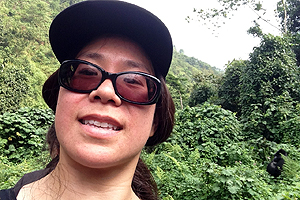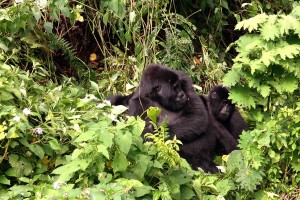The earliest I can recall thinking that it would be amazing to see a gorilla in the wild, was when an outstandingly well-travelled family friend spoke almost reverently about her experience doing exactly that. It was, she said, one of the most humbling experiences as a human being. That was thirty-odd years ago.
Since then, our friend passed away, gorilla trekking has become somewhat more accessible, and after two visits to Uganda, I’d still not made it out west to Bwindi National Park, a sanctuary that half the world’s 800 or so mountain gorillas call home. The only other places that you can trek mountain gorillas are in the neighbouring national parks in Rwanda and the Democratic Republic of Congo.
The realization that I might not have the good fortune of returning to this beautiful country spurred me into action. After contacting half a dozen tour agents, I ran up against the same reason that had stopped me going ape previously: cost.
Gorilla trekking is a not inexpensive business. A permit, of which there are 8 per day per family group, costs $500. Then there is getting to Bwindi, which is affordable given the time to trundle along in shared transport. But if you can only spare a three-day weekend, you can’t spend most of it just getting here. Finally, accommodation. Here, there are lots of options, and although the budget choices are slightly higher than the same accommodation elsewhere, you’re paying a gorilla premium.
I was resigned to putting it off until some day, when an agent contacted me to offer a steep discount if I took over a cancelled booking. There was one permit still available at Nkuringo. Accommodation would be at the most high-end venue: Clouds Mountain Gorilla Lodge. Yes was the only answer.
I spent Friday afternoon with the Batwa tribe. (Read about that here.) Saturday was G-day.
Our start was delayed due to a group going to the wrong trekking station, so at 8:30am we finally set off. Our group: four American law students, a pair of Fins and a lone South African. The support team consisted of our guide Mr. Taban, two armed rangers, five porters and six advance trekkers with pangas.
The advantage of trekking the Nkuringo gorillas is that their ranging habits seem to make them easier to locate. The cost is that the trekking is not for the unfit, the vertigo sufferer or generally anyone rendered faint of heart walking along a narrow strip next to a precipitous plunge.
Apparently it’s relatively easy going trekking for all the other groups. At Nkuringo you are either going straight down or straight up an insanely steep gradient, which underfoot is either loose rocks, slippery sand, or slithery mud. Repeat the aforementioned in knee-killing succession until you find the gorillas, or turn around after five hours of unsuccessful trekking and resolve to try again another day.

For a change I have myself in the photo, thanks to the iPhone feature. This is a mother with her twin young gorillas behind me.
Given the terrain, I was glad to have followed advice and have the assistance of porter Richard Tumushabe who prevented me from:
i) Taking the short cut, which is the same one people take when they plummet off the side of the Grand Canyon, except the pathways there are like four-laned highways in comparison to the narrow, friable track at Nkuringo;
ii) Twisting my ankle, which would have put an end to the trek for me; and
iii) Doing both of the the above with assistance of my day pack containing 2 litres of water, lunch, a raincoat, a pair of gloves for the stinging nettles and a hoodie for the cold.
While going downhill was challenging for me (next time, knee braces and actual hiking boots), going uphill was just fine. For those whom it was not fine, a pair of porters provided the necessary push and pull.
We were extremely fortunate to not have to endure too much hiking to get to the gorillas, as they had been enjoying the secondary forest growth for the past few days. This vegetation is younger, and therefore sweeter and more succulent. It also makes seeing and photographing the gorillas much easier than in the gloom of the old growth forest floor. (No flash allowed.)
We spent a remarkable hour with this 14-member family. I kept losing track and count, for it is remarkably easy for an entire 200 kilogramme gorilla to vanish into the thick vegetation right before your eyes! We saw all three of the silverbacks (the hair on the back of the males turns silvery grey around 14 years of age), including the dominant male and an elderly male. Three mature females, including the one who had given birth to twins, who stayed close to her. And three other baby gorillas who put on a show climbing up the vegetation, wrestling one another and one who thumped his chest King-Kong style.
I’m embarrassed to admit that I was initially so excited that my first photos were either completely blurred (granted, this was of a silverback in thick, gloomy forest), or feature barely identifiable parts of gorillas or only vegetation, as I inadvertently managed to set my iPhone to not photograph what was on the screen. But I eventually got it straightened out. Click here to see my photos of gorillas *without my grinning mug*! I have some even better videos, and am trying to edit them together to share.
Afterwards it was lovely to return to Clouds Gorilla Mountain Lodge and enjoy the views over those knee-killing Bwindi rises. (The eight volcanoes of the area weren’t visible while I was there because of the… clouds. Truth in advertising!) If you can afford it (or luck into a serious discount), a cottage at Clouds with your own butler and housekeeper and the option of a post-trek massage is how to do this in style. You also get to feel like your funds are doing some good. Clouds is a community partnership business and has made good on the intentions of creating jobs, providing training and pumping resources back into the local community. The staff are local and consummate professionals. (Innocent is deserving of the gushing praises on Trip Advisor.
Overall I was struck by the thoughtful management of these hairy ambassadors, with government and the private sector working to ensure that the benefits of gorilla tourism are felt within the local community.
Our friend was right. Being able to observe these great apes, with whom we share almost all of our DNA, is a remarkable experience. You witness the same care, mischievousness and bonding as we ourselves exhibit. And that reminds one of what it means to be human.


No responses yet